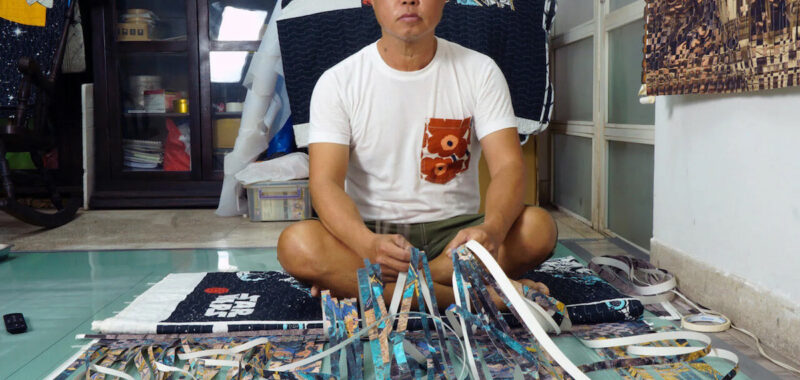
Vietnamese American visual artist Dinh Q. Lê, who died in April at the age of 56, has left behind an enormous and influential legacy through his woven photographic tapestries probing personal, cultural, and national identity pertaining to the post-war diaspora. Lê’s resounding impact on the Southeast Asian contemporary arts sphere is evident not only in his practice, but also in his devotion to nurturing a community for promising young Vietnamese artists throughout his lifetime.
The spotlight brightens on Lê next month as Swann Auction Galleries highlights one of his early-career tapestries in its upcoming LGBTQ+ Art, Material Culture and History sale on August 22. In “Self Portrait #5 (Portraying a White God Series)” (1989), the artist interpolates himself into a characteristically Western depiction of the Crucifixion of Jesus Christ, mirroring Jesus’s position on the cross such that their heads overlap — perhaps heralding his fixation on Siamese twins later in his practice. As Lê recalled in a 2010 interview, his initial weavings “were really about me trying to locate my place in America, in the West.”

Dinh Q. Lê’s “Self Portrait #5,” explained Corey Serrant, the auction specialist for the forthcoming Swann sale, “grapples with the artist’s spiritual, cultural, and personal identities.”
“The undercurrents of the work use the well-known imagery of the crucifixion of Christ to explore Lê’s relationship as an American immigrant from Vietnam and his queerness,” Serrant told Hyperallergic.
Born in the southern Vietnamese town of Hà Tiên that borders Cambodia, Lê and his family fled the country by boat in 1978 when he was 10 years old, as Khmer Rouge troops descended on the land. The artist, his mother, and his siblings spent a year in refugee camps in Songkhla, Thailand, awaiting their application approvals before moving to suburban Simi Valley, California, in 1979.
Lê struggled with English while attending high school, leading him to spend his lunch breaks looking at Renaissance art books at the library. “My aunt had taught me to weave mats as a child, so I ended up literally weaving myself into these Italian and Flemish paintings that I was so enamored with,” he told the Brooklyn Rail in 2010.

Lê received an undergraduate degree in Fine Arts from the University of California, Santa Barbara, and a graduate degree in Photography from the School of Visual Arts in New York City before ultimately deciding to return to Vietnam, settling in Ho Chi Minh City (Saigon) in 1996, two years after the United States embargo was lifted.
“When I was in America, I never really fit in, and kept harbouring this romanticised image of Vietnam,” Lê told Singaporean media outlet Bakchormeeboy last year, unpacking his experiences about displacement, assimilation, and selective memories within the notions of belonging. “When I went back, it was completely different from my memory, but somehow deep down I knew it’s where I’m supposed to be.”
Throughout his career, the artist literally interlaced Vietnamese history and culture into moments of the present through his archival photographic and media-based weavings, as well as sculptural installations and film. Processing not only his own displacement and journey of return, but the countless stories of other Vietnamese refugees who endured atrocities and were forced to leave everything behind in order to survive, Lê’s meticulous artistry brings much-needed consideration and exposure to lesser-told histories.

Lê, a gay man, also kept his finger on the contemporaneity of Vietnamese social culture as it evolved. He devoted a series of work, Skin on Skin, to the country’s subversive sexual revolution rooted in access to adult media through the internet from the 1990s through the 2000s. The artist wasn’t known for explicitly addressing queerness, romance, or eroticism in his art, but the manner in which he juxtaposed fragmented memories of the past with the present connotes a rebellion growing rhizomatically beneath the Western narrative’s crumbling surface layer. This is also emphasized in his commitment to the creative future of Vietnam through the co-founding of Sàn Art — an incubator for contemporary and experimental media in Ho Chi Minh City.
Woven well before Lê gained popularity, “Self Portrait #5” marked the artist’s shift away from seeking belonging, instead forcibly inserting himself and his culture into areas that didn’t intend to include him.
Serrant explained that after the artist’s return to Vietnam, “Lê’s sexual identity takes an ancillary role to his Southeast Asian diasporic identity as the metamorphosis that undoubtedly comes with uncovering a resolution of the sexual self and historical memory.”
“The merging of selves leads to an expression of contention between Southeast Asian diasporic identity and Western individuality,” he concluded.
This article, part of a series focused on LGBTQ+ artists and art movements, is supported by Swann Auction Galleries. Swann’s upcoming sale “LGBTQ+ Art, Material Culture & History,” featuring works and material by Dinh Q. Lê, Harmony Hammond, Tom of Finland, and many more will take place on August 22, 2024.

